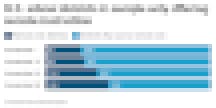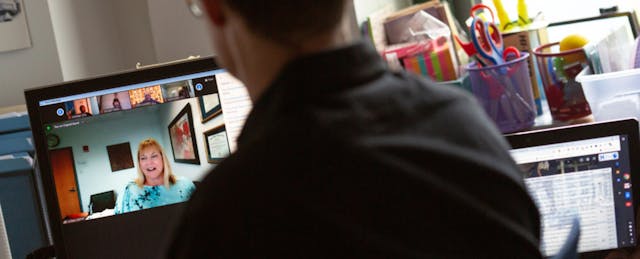When educators describe their frenzied switch to remote learning in the spring, most talk about being caught off guard. Some mention how little they knew then—about virtual learning, as well as the virus that forced them out of their school buildings. Others shudder at the tight timeframe they were given to completely reconstruct the instructional day. There was no time for preparation or “best practice.” It was an emergency.
But nine months have passed since then. Many school districts used the summer to regroup, to train their staff and to get a plan for the fall—first on how to reopen, and then on how to respond should the situation change, for better or worse. One thing was clear: Many felt that what happened in the spring should not happen again. They needed to find ways to reach their students, engage them, motivate them and connect with them in ways that built on the lessons they had learned from the first few months of the pandemic.
Since the start of the new academic year, schools in many states reopened for in-person instruction in some capacity. But as the winter surge of the coronavirus has crept in, with rising infection rates and growing case counts, many have returned to full-time remote learning. According to an EdSurge/Social Context Labs analysis, 22 percent of a sample of 375 districts around the country were fully remote on Nov. 1. By the end of the month, that figure had ticked up to 38 percent.
At least this time, they feel better prepared.
Among them is Waterbury Public Schools, which shut down on Nov. 12. Instead of relying on the paper packets that largely defined the Connecticut district’s remote instruction in the spring, Waterbury was ready to bring students and staff online this time.
“We didn’t know how long this would last,” Darren Schwartz, chief academic officer at Waterbury, says of the pandemic. But he recalls thinking and telling staff emphatically that “if we start next year virtual, we’re not handing out packets.”
Waterbury purchased 16,000 new devices for its students and devoted much of its seven professional development days over the summer to training teachers on Google Classroom and other tools and systems the district would be bringing into the fold.
“To me, it’s a completely different approach from the spring to now,” Schwartz says. “The transformation from paper packets being passed out to synchronous lessons and learning, being connected to adults and knowing that the teacher will be there for you, that’s a huge shift for us—one that needed to happen, but that we weren’t prepared for.”
After processing what happened in the spring, the district also re-envisioned the way it gets in touch with students’ families. In March, Waterbury didn’t have a direct way to communicate with parents and caregivers. It didn’t even have correct contact information for about a fourth of them. That led to chaos, confusion and families flooding the phone lines at the district’s central office when schools were shuttered in March. “We were archaic in our ability to reach families,” Schwartz acknowledges, adding that much of the onus fell to principals and teachers.
Since then, Waterbury has adopted a communication tool called ParentSquare and signed up all but a few hundred of its 18,700 families. So when the district made the decision to shut down on Nov. 12, nearly every family was informed of the switch within two to three minutes.
Other districts were able to offer some online learning in the spring, albeit unevenly. Oklahoma City Public Schools (OKCPS) had nearly enough devices for everyone to participate in digital learning, but many students lacked sufficient internet access at home and ultimately had to learn from paper packets. For those who did learn online, teachers’ tech savviness varied greatly, says Julie James, director of professional development for the district. It was important to get them all on the same page around digital learning before starting a new school year.
After negotiating with its teachers’ union, OKCPS offered three weeks of mandatory professional learning over the summer—swapping some in-person instructional days for the training and paying its teachers to attend. All 5,000 staff attended, together completing 67,000 courses over the three weeks.
The first week of learning this summer focused on equity and mental health, then moved into digital platforms and training for specific tools. Courses about Canvas, the district’s learning management system, explored how to create pages in the system, how to design quizzes and how to submit grades. Others dove into tools such as Edgenuity, Seesaw, ELQA and Florida Virtual School.
Still other courses were more generalized, getting at common challenges teachers have experienced while teaching remotely. Their titles ranged from “Managing the Digital Classroom” to “Up-Close Learning in a Distanced World” to “Play-Based Learning in a Remote Setting.”
“We filled them up probably more than they ever wanted to learn in those three weeks,” James says. “It’s really hard to learn something new and just keep ingesting all this new learning; adults in this business like to get a small chunk and practice a little bit, then get another small chunk. But because of the dire circumstances, everybody had to do the best they could—learn, create and be ready when students were in classes.”
Most of OKCPS’ 45,000 students started the fall semester fully remote. By then each was equipped with a device and, if necessary, a hotspot to help them get online. The district opted for a phased reopening, with special education students coming back first, then pre-K students, ultimately bringing all grade levels into its hybrid learning model, fully operationalized, on Nov. 10.
Just three days later, as the state crossed over from level orange (moderate risk for COVID-19) to red (high risk), the district was forced back to remote learning, which will remain in place at least until the new semester begins in January.
What James has heard from teachers is that they feel “very confident” navigating the various digital learning platforms and tools that OKCPS has rolled out. “That is not as difficult,” she explains. “What they want additional support in is how to engage students in a highly complex manner in online learning, and how to keep students engaged. Those are the big ones that are challenging our instructional staff now. How do we teach really well and really creatively online?”
She continues: “The feeling right now I hear from staff members is that digital learning is not in-person learning. It’s not just students’ relationship with teachers, but students’ relationships with other students. It’s hard to build relationships with students in a Zoom chat. You can work on math problems and science problems, but they’re missing that in-person interaction and enrichment and sports and music—those extracurriculars that make up a well-rounded student experience.”
Those are challenges that can’t quickly be remedied in a professional learning course, she acknowledges.
Adjusting on the Fly
A significant number of districts have reverted back to remote learning in the last few weeks, as nearly every region of the U.S. struggles to control the spread of the coronavirus. But others made that switch earlier—and haven’t reopened since.

Mike Slowinski, the principal at Menasha High School, in Menasha, Wis., says that even as his school started the year on Sept. 1 with a hybrid model, plans were in place for a sudden transition to all virtual learning if it became necessary. And it did—less than four weeks later. Not only were cases rising rapidly in the community, but as more staff in the building had to quarantine after exposure to COVID-19, the school struggled to find people who could fill in for them.
“Substitute teachers are always hard to come by,” Slowinski explains, “but this time it was even more challenging. The pool was small, because many of our substitute teachers are retired teachers, and they are at a higher risk. So it was a much bigger strain to operate our building as normal.”
The district moved everyone to remote learning on Sept. 25. It was a transformed experience from the spring, when teachers would post assignments in Google Classroom for students to complete on their own time. There was no live group instruction or face-to-face class meetings, only comments in Google Docs and email exchanges.
Part of that was because not all students could access a live virtual meeting. Like OKCPS, some students in Menasha had to use paper packets while the district worked out a way to get them a reliable internet connection. Another issue was the district did not have a learning management system that was used consistently across its schools. Both issues were resolved by the fall. Students who lack home internet access now have hotspots, and the district adopted Schoology, which teachers learned to use during professional development over the summer.
“To have the benefit of the experience from last spring, and the entire summer to plan, that really helped us to be as prepared as possible,” Slowinski says. “We were able to learn from some of the lessons of the previous spring and make some adjustments to our model and our approach. We still feel strongly that the best way to do school is in classrooms, but certainly the education and support students are getting this fall is at a higher level.”
Thinking back on how the events of the spring transpired, Slowinski says that for a long time, everyone expected to return to in-person classes after the initial closure. The return date got pushed out another two weeks, then another—until they officially decided to remain remote for the rest of the school year.
“As it continued to go on, we made adjustments as we could,” he says. “But when we felt like we were going to be out for two weeks and then come back, there wasn’t a need initially to create a synchronous schedule.”
He goes on: “To make such a big shift, to put something like that in place, requires a lot of time and communication. With the benefit of time to plan, and experience, and knowing more about this virus as well, I can say we’ve made some pretty big improvements this year compared to when it was so brand new to us last [school] year.”


